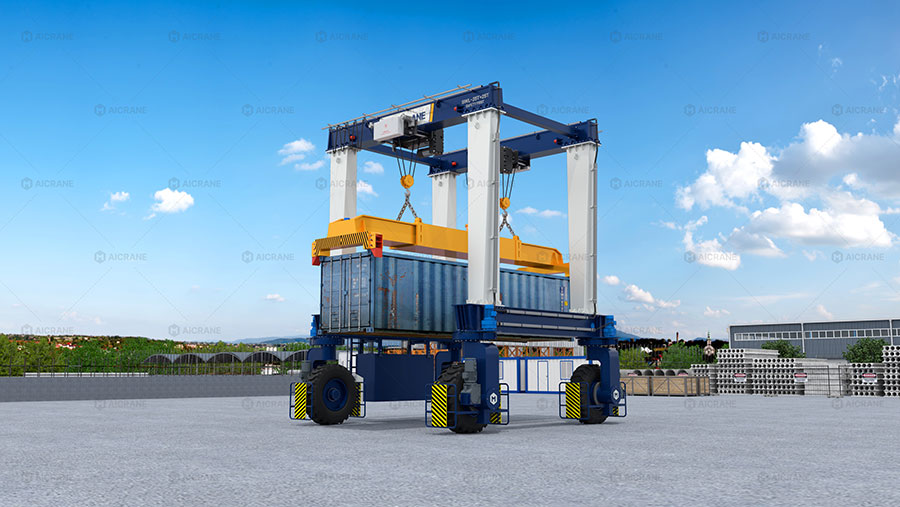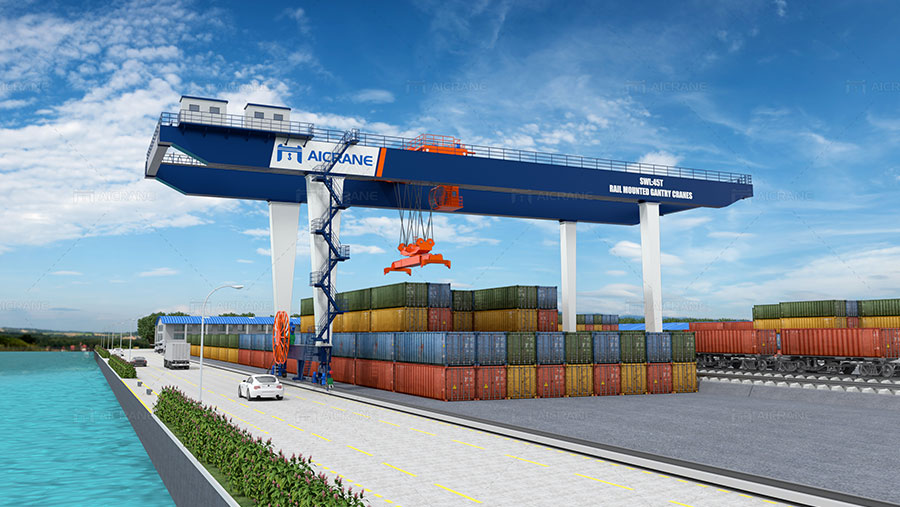Gantry cranes are a type of crane commonly used for heavy lifting and transportation tasks in various industries, including port operations, construction sites, and manufacturing. The two most widely used types of gantry cranes are rubber-tyred gantry cranes (RTGs) and rail-mounted gantry cranes (RMGs). Though they serve similar functions, their structural designs differ significantly, and understanding these differences is crucial for selecting the appropriate crane for specific tasks. In this article, we will explore the key structural differences between RTGs and RMGs, focusing on factors such as mobility, stability, capacity, construction, and maintenance.
1. Mobility and Movement
One of the most significant differences between rubber-tyred gantry cranes and rail-mounted gantry cranes lies in their mobility. This is primarily influenced by their respective mobility mechanisms and guiding systems.
Rubber-Tyred Gantry Cranes (RTGs):
-
Mobility: As the name suggests, rubber tyred gantry crane is equipped with rubber tyres, which provide flexibility and the ability to move freely over unprepared ground surfaces. This allows RTGs to be used in a variety of environments, including outdoor areas, uneven terrains, and areas without dedicated tracks.
-
Steering: RTGs are typically equipped with self-propelled wheels that can rotate independently, enabling the crane to move in multiple directions (e.g., forward, backward, sideways). This steering flexibility offers a higher level of maneuverability compared to rail-based systems.
-
Operation: RTGs are often used in areas where space is constrained or when cranes need to move between various locations. For example, in container terminals, RTGs can be moved between different rows of containers, or from one quay to another, providing a high level of operational flexibility.

Rail-Mounted Gantry Cranes (RMGs):
-
Mobility: Unlike RTGs, rail mounted gantry crane is mounted on rails or tracks that restrict their movement to pre-defined paths. This offers high precision in positioning, making RMGs suitable for areas where accurate, repeatable movements are required, such as container yards with fixed layouts.
-
Guidance System: RMGs rely on a rail system for movement, which is usually fixed and laid along specific routes. While this limits the crane’s mobility, it ensures that the crane’s movement is stable, precise, and repeatable.
-
Operation: RMGs are used in situations where cranes are expected to travel along fixed routes or within defined working areas, such as container ports with established rail lines for loading and unloading containers.

2. Structural Design and Construction
The structural design of RTGs and RMGs differs based on their mobility systems, load capacities, and intended operating environments.
Rubber-Tyred Gantry Cranes (RTGs):
-
Main Frame and Wheels: RTGs have a wheeled frame designed to support the weight of the crane, the load, and the necessary mechanical components. The rubber wheeled gantry crane is mounted on rubber tyres, which allow it to travel along the ground or on asphalt without the need for a fixed track.
-
Lifting Mechanism: Like most gantry cranes, RTGs are equipped with a trolley system that moves along the horizontal gantry beams. The lifting mechanism consists of hoists and spreaders designed for heavy lifting, such as stacking and unloading containers.
-
Load Distribution: The load is distributed across the rubber tyres, allowing for a more even weight distribution over the surface. However, this means that RTGs typically have a lower lifting capacity per tyre compared to RMGs, and their total lifting capacity is dependent on the design of the tyres and the surface conditions.
Rail-Mounted Gantry Cranes (RMGs):
-
Main Frame and Rails: RMGs are designed with a sturdy steel frame that is mounted on rails or tracks. The design incorporates large rail-mounted wheels that run along the tracks, providing a stable and secure foundation for lifting operations.
-
Lifting Mechanism: Like RTGs, RMGs also feature a trolley system that can move along the horizontal beam to lift and stack containers. The key difference is that the trolley on an RMG typically operates with a fixed guiding system along the rail, ensuring stability and precision when lifting heavy loads.
-
Load Distribution: The rail-based design of RMGs allows for better weight distribution, particularly when handling large and heavy loads. The crane’s structure is optimized to handle higher lifting capacities than RTGs, thanks to the increased stability provided by the rails.
3. Stability and Load Capacity
Stability and load capacity are crucial factors to consider when selecting an overhead gantry crane for a specific task. Both RTGs and RMGs are designed to handle heavy loads, but their stability is influenced by their construction.
Rubber-Tyred Gantry Cranes (RTGs):
-
Stability: RTGs, although highly maneuverable, have less inherent stability than RMGs because they rely on rubber tyres for support. The stability of an RTG depends heavily on the quality and condition of the tyres and the terrain on which it operates.
-
Load Capacity: RTGs are typically used for lighter to medium lifting tasks, especially in environments where mobility and flexibility are essential. However, their load capacity is generally lower than that of RMGs, as they are restricted by the limitations of the rubber tyres. Typically, RTGs are used for lifting up to 40-50 tons.
Rail-Mounted Gantry Cranes (RMGs):
-
Stability: RMGs, being mounted on fixed rails, offer superior stability compared to RTGs. The rails provide a solid foundation, allowing RMGs to handle much heavier loads without the risk of tipping over or experiencing instability during operations.
-
Load Capacity: RMGs are ideal for handling heavier loads, often ranging from 50 tons to over 100 tons, depending on the specific crane design. The rail-based structure allows for better load distribution and greater lifting capacities, making RMGs suitable for tasks involving large containers, heavy machinery, or other industrial loads.
4. Maintenance and Operational Costs
Both RTGs and RMGs require regular maintenance, but their maintenance needs differ due to their distinct design and operational environments.
Rubber-Tyred Gantry Cranes (RTGs):
-
Maintenance of Tires: The rubber tyres of RTGs require regular maintenance and occasional replacement due to wear and tear, especially when operating on rough or uneven surfaces. Tire maintenance can increase operational costs, particularly in environments with heavy traffic or harsh conditions.
-
Surface Wear: RTGs also tend to cause wear on the ground surfaces, particularly in high-traffic areas. This may require resurfacing or repair of the operational area over time.
Rail-Mounted Gantry Cranes (RMGs):
-
Rail Maintenance: RMGs, while requiring less frequent maintenance on their wheels, require ongoing care of the rail system, including track inspection and alignment. Over time, rail wear and tear can affect crane precision and operational efficiency.
-
Lower Tire Maintenance: Since RMGs use steel wheels on rails, they experience less wear compared to RTGs, resulting in lower tire maintenance costs.
5. Suitability for Different Environments
The operational environments for RTGs and RMGs vary based on their mobility, stability, and design.
Rubber-Tyred Gantry Cranes (RTGs):
-
Flexible Use: RTGs are more suitable for dynamic environments where cranes need to move between different locations, such as in container yards, shipyards, or logistics facilities with a need for flexibility and maneuverability.
-
Outdoor Applications: RTGs can be used in environments without the need for tracks, making them ideal for outdoor operations, especially in areas where installing rail systems would be impractical or too expensive.
Rail-Mounted Gantry Cranes (RMGs):
-
Fixed Applications: RMGs are best suited for environments where fixed paths and precise operations are needed. They are commonly used in large container ports, intermodal yards, and other industrial facilities where precise and consistent lifting tasks are required along predetermined routes.
-
Indoor or Rail-Restricted Environments: RMGs are typically more suitable for indoor applications or areas with established rail systems, where their fixed movements can provide better operational efficiency.
Conclusion
While rubber-tyred gantry cranes (RTGs) and rail-mounted gantry cranes (RMGs) share similar purposes, such as heavy lifting and container handling, they differ significantly in terms of mobility, stability, load capacity, and maintenance. RTGs offer higher flexibility and maneuverability, making them ideal for outdoor and dynamic environments, while RMGs offer superior stability and load capacity, making them well-suited for fixed, high-precision tasks in controlled environments.
Choosing between an RTG and an RMG depends on specific operational needs, including terrain conditions, load capacity requirements, and maintenance considerations. Understanding these key structural differences will enable businesses to make an informed decision on which type of gantry crane is best suited to their operations.
